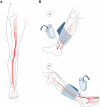Comprehensive foot examination and risk assessment: a report of the task force of the foot care interest group of the American Diabetes Association, with endorsement by the American Association of Clinical Endocrinologists
- PMID: 18663232
- PMCID: PMC2494620
- DOI: 10.2337/dc08-9021
Comprehensive foot examination and risk assessment: a report of the task force of the foot care interest group of the American Diabetes Association, with endorsement by the American Association of Clinical Endocrinologists
Figures



Republished in
-
Comprehensive foot examination and risk assessment. A report of the Task Force of the Foot Care Interest Group of the American Diabetes Association, with endorsement by the American Association of Clinical Endocrinologists.Phys Ther. 2008 Nov;88(11):1436-43. doi: 10.1093/ptj/88.11.1436. Phys Ther. 2008. PMID: 19137633 No abstract available.
References
-
- Mayfield JA, Reiber GE, Sanders LJ, Janisse D, Pogach LM: Preventive foot care in people with diabetes. Diabetes Care 21:2161–2177, 1998 - PubMed
-
- American Diabetes Association: Preventative foot care in people with diabetes. Diabetes Care 26(Suppl. 1):S78–S79, 2003 - PubMed
-
- Singh N, Armstrong DG, Lipsky BA: Preventing foot ulcers in patients with diabetes. JAMA 293:217–228, 2005 - PubMed
-
- Abbott CA, Carrington AL, Ashe H, Bath S, Every LC, Griffiths J, Hann AW, Hussain A, Jackson N, Johnson KE, Ryder CH, Torkington R, Van Ross ER, Whalley AM, Widdows P, Williamson S, Boulton AJ: The North-West Diabetes Foot Care Study: incidence of, and risk factors for, new diabetic foot ulceration in a community-based patient cohort. Diabet Med 19:377–384, 2002 - PubMed
-
- Reiber GE, Vileikyte L, Boyko EJ, del Aguila M, Smith DG, Lavery LA, Boulton AJ: Causal pathways for incident lower-extremity ulcers in patients with diabetes from two settings. Diabetes Care 22:157–162, 1999 - PubMed
Publication types
MeSH terms
LinkOut - more resources
Full Text Sources
Other Literature Sources
Medical

